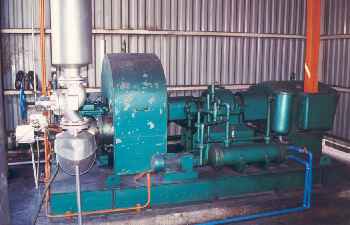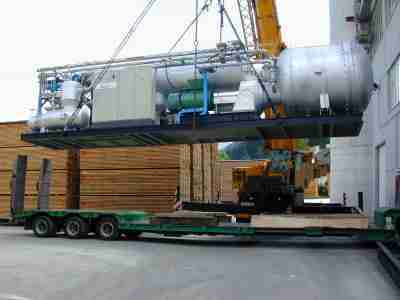For power production through biomass combustion, steam turbines and steam piston engines are available as proven technology. While steam engines are available in the power range from approximately 50 kWe to 1 MWe, steam turbines cover the range from 0.5 MWe up to more than 500 MWe with the largest biomass-fired plant around 50 MWe.
 |
| Example of small-scale biomass fired CHP system. In a rice drying and packaging plant in Malaysia, rice husk is burned in a water cooled step grate furnace to generate steam (17,5 Bar) for a single stage 225 kWe backpressure turbine. Remaining heat is used for paddy drying. |
Small-scale steam turbines are usually built with a single expansion stage or few expansion stages, and operated at quite low steam parameters as a result of the application of firetube boilers. Plants smaller than 1 MWe are usually operated as backpressure CHP plants and aim for electricity net efficiencies of typically 10% to 12%. The backpressure heat can be used as process heat.
Steam piston engines can also be used for small-scale applications, enabling efficiencies of 6% to 10% in single-stage and 12% to 20% multi-stage mode. Steam engines are relatively robust – even saturated steam can be used.
For large steam turbine plants, water tube boilers and superheaters are employed, thus enabling high steam parameters and the use of multi-stage turbines. Furthermore, process measures such as feed water preheating and intermediate tapping are implemented for efficiency improvement. This results in electricity efficiencies of around 25% in plants of 5 to 10 MWe.
In plants around 50 MWe and larger, up to more than 30% is possible in cogeneration mode and up to more than 40% if operated as condensing plant.
 |
| 400 kWe ORC plant, fired by a biomass grate furnace using sawdust and woodchips as fuel in Admont, Austria; the remaining heat is used for drying purposes and for district heating. (Courtesy of Turboden Srl, Italy) |
As an alternative to conventional steam plants in the range 0.5 MW to 2 MW, Organic Rankine Cycles (ORC) using a thermal oil boiler instead of a costly steam boiler are also available, enabling operation at lower temperatures. A few plants are in operation with biomass combustion. ORC plants can be operated without superheater due to the fact that the expansion of the saturated steam of the organic medium leads to dry steam.
 |
| 35 kWe Stirling engine for biomass combustion plants. (Courtesy of Henrik Carlson, Denmark) |
Another interesting development for small-scale biomass power
production is the externally fired Stirling engine. A 30 kWe prototype plant has reached approximately 20% electric efficiency in CHP operation.
Up to 28% efficiency is aimed at by improving the process and scaling up to 150 kWe. It is expected that Stirling engines may enable economic small-scale power production by biomass combustion in the future.
In spite of the high complexity, closed gas turbine cycles or hot air turbines may become attractive for medium-scale applications. Before market introduction, however, development of process and component design


